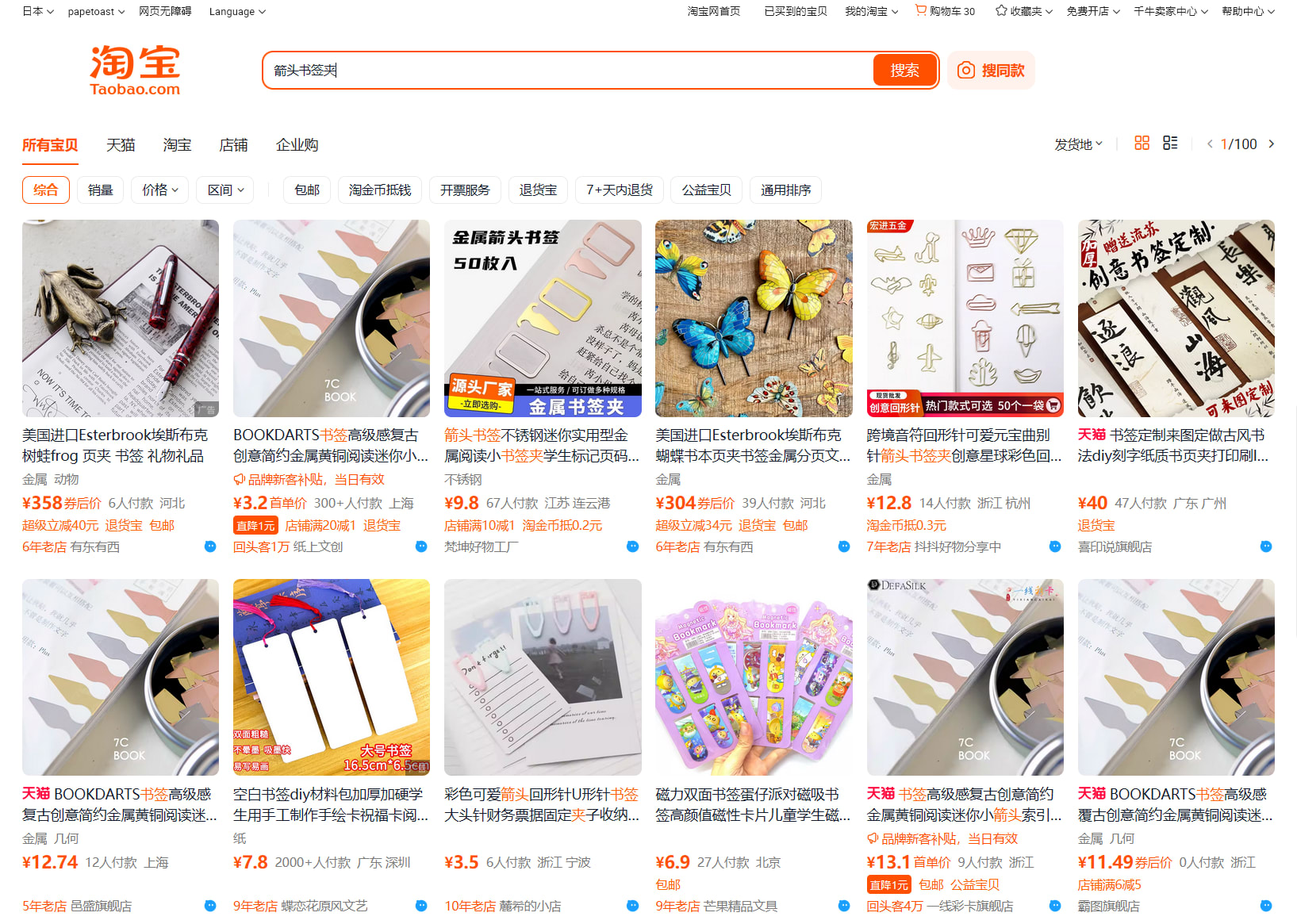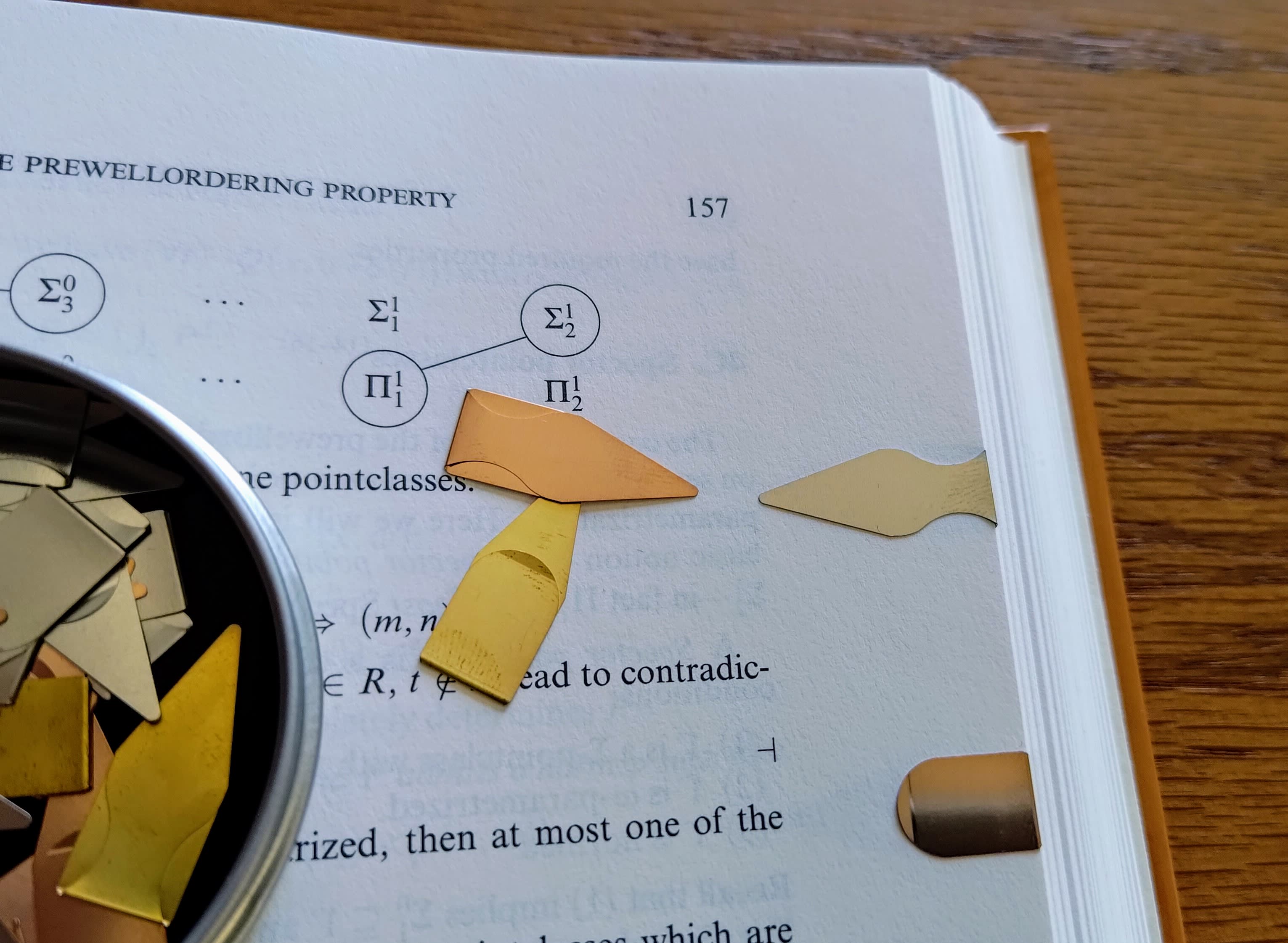Somebody invented a better bookmark
10gwern
2Three-Monkey Mind
9Gordon Seidoh Worley
16leogao
5Alex_Altair
3TristanTrim
9cqb
5David Hornbein
4DanielFilan
6DanielFilan
2DanielFilan
3DanielFilan
4Alex_Altair
3Yoav Ravid
3Veedrac
2Alex_Altair
2Veedrac
3J Thomas Moros
2CronoDAS
4Alex_Altair
2CronoDAS
2papetoast
1solhando
New Comment
Wouldn’t they need to make right- and left-handed manicules unless they went for, like, a hamsa hand?
These seem nice, but I don't expect to buy any. Why? Because they don't seem clearly better than what I currently do, which is dog-ear pages.
Why dog-ear?
- I can always dog-ear (don't have to remember to bring anything with me).
- I can't lose the dog-ear.
- Paper is pretty resilient.
- I can dog ear the top or bottom corner.
- I can dog ear either direction to indicate the page.
- I have a record of what pages I dog-eared in the past (and what pages others dog-eared if it's, say, a library book).
- Free.
Obviously I would not dog-ear a rare or antique book, but for almost anything published after, say, 1950, I dog-ear.
As a fellow heretical dog-ear lover, let me tell you about my dog ear ritual upon acquiring a new book with content I wish to frequent...
First I explore the table of contents and skim a little bit, noting how the content is broken up into sections and subsections. Usually I determine that two "levels" will be good, so I draw my fingernail across the side of the closed book near the top corner to create two indented lines across all the pages in the book. These serve to indicate the location where the dog ear fold should come to.
Be careful when making the lines! If they are too low you may cover up the page numbers 0___0. I like going about 5 and 10 mm.
Then I grab all the pages of the table of contents and dog ear them together. This causes each successive pages dog ear to be just a little bit smaller than the last making them easier to flip through. I pull each page apart and press the folds flat individually. I like to have the table of contents down lower than the two indicator lines making the table of contents very obvious.
Next I flip through the book to the start of each chapter, folding down the corner of the right-hand page (even if the chapter starts on the left-hand page. I'm still settling the technique, but folding to the smaller line creates a more noticeable gap because of how the dog ear folds mesh into one another, so I think it is preferable for chapters to be the smallest dog ears.
Then I start with the chapters I'm most interested in, or, if I have time to lose myself in the enjoyment of knolling, I will go through the book from start to finish folding down the right hand page to the second line for each of the sections. I find this page flipping also gives me a nice preview of the contents of the book.
Finally I will repeat the process for folding the table of contents on the index pages. If there is a glossary I will do the same for it at a level in between the subsection level and the index level.
The top corner of the book is now a completed pack of dog ears. The bottom section is left for dog ears for contents of interest. Unlike the chapter and section ears, I place these on the right or left page to indicate which one is of interest. I have not yet encountered a worthwhile page on both sides of a single sheet of paper. I am not sure what I would do if I did.
Haha. I hope if you read all of this it either amused you or inspired you to become a dog earing weirdo such as myself.
These metal page makers are great! Another thing in a similar vein are the midori index clips but a little more pricey. They also have a little notch in them, sometimes I will slot a small piece of coloured paper in there so I can visually categorize what the clip is marking.
I will also sometimes mark pages with differently shaped paper clips (also helps with category identification) if I don't care too much about adding bulk, usually in my notebooks.
One thing I like to do is use postcards as bookmarks. They often have nice art and remind me of cool things.
Thing I did not realize: they cost significantly less if you order from the Book Darts website rather than Field Notes.
That said I expect to find this very useful for my current reading, which is largely slowly making my way thru big chunks of Latin, a language that is foreign enough to me that I have to think about where I'm up to.
How do these hold up in backpacks / luggage bags? I'm worried they'd catch on stuff and tear pages more than other bookmarks (that can be pushed totally into the book).
I don't think I've ever had one fall off in a bag! The only time I can recall them falling off/catching is if I start flipping through the book and the page facing the "back" of the dart slips into the tiny fold and pops it off.
The second disadvantage is that you lose the opportunity to have a tiny bit of art in your life. Paper bookmarks are often beautiful.
It's possible to make ones with engraving, and to have a more special shape
These seem neat but not obviously meaningfully better for the referenced tasks than a sticky index tab, if running multiples. The darts do look suave though, and I'm sure they last better.
I also recently had need to homebrew some permanent book labels without them, and found that folded over labels from a label maker made a pretty nice and reasonably quick index.
I'll admit I don't have much need for optimizing physical bookmarks myself these days, but I expect you're underestimating how reusable and replaceable an adhesive tag can be. Not that I think it matters; at best it'd be an essentially similar item to what you already use.
I've been a long-time user of book darts and highly recommend them.
The one other downside is that if they are on the page and catch on something so that they rotate, the clip can cut into the page edge. This can generally be avoided by making sure you put them all the way to the edge of the page and being aware not to let anything drag along the edge of the pages of a book with darts in it.
As always you can find it in Taobao aka Chinese e-commerce website (ChatGPT recommended me to search with 箭头书签夹 [lit. Arrow Bookmark])
https://s.taobao.com/search?ie=utf8&q=箭头书签夹&search_type=item (login required)

I write in the books I read so I just flip to about where I stopped underlining or taking notes.
Curated and popular this week
